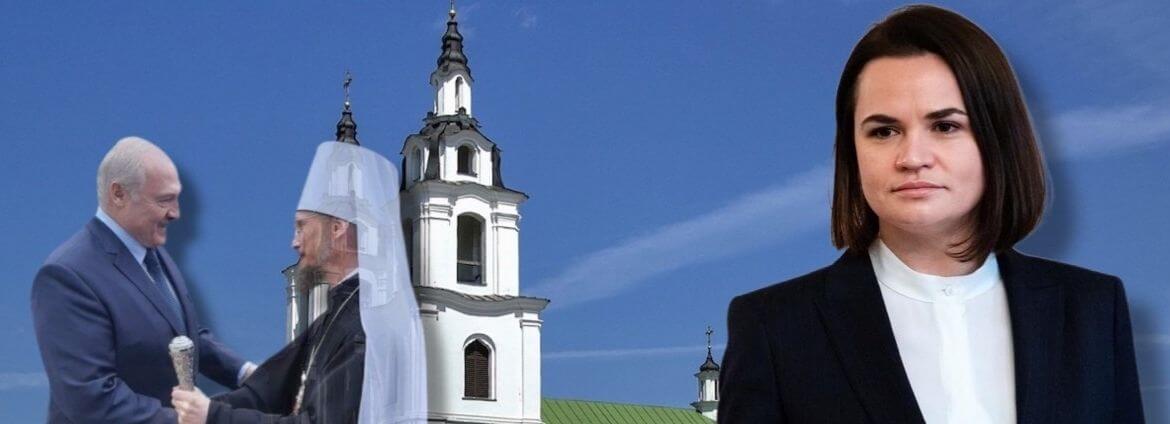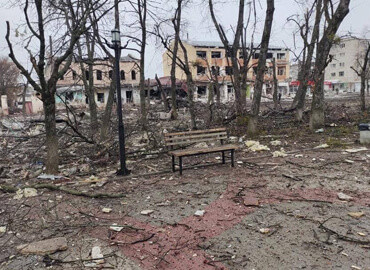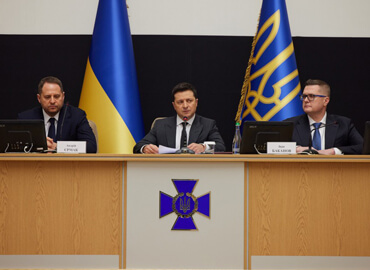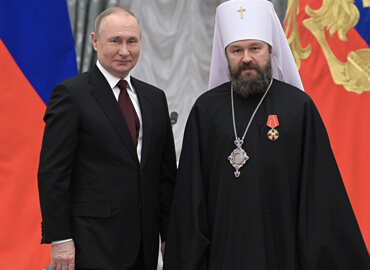On July 25, during Svetlana Tikhanovskaya’s visit to the U.S., the pro-Kremlin Telegram channel Brief@nezygar published the following: «Tikhanovskaya visited the Belarusian Autocephalous Church in New York and promised to appeal to the Patriarch of Constantinople with a request to grant the Patriarchal and Synodal Tomos of the autocephalous church structure of the Belarusian Orthodox Church.»
First, this information does not correspond to facts. Neither the headquarters of Tikhanovskaya nor the representatives of the Belarusian Autocephalous Church announced anything like that. In the published speech of the leader of the democratic movement, in video broadcasts or recordings of Svetlana Tikhanovskaya’s nearly hour-long stay of in the cultural center of the Belarusian diaspora in New York, located in the same building as Cyril Turovsky’s parish of the Belarusian Autocephalous Orthodox Church, there is not a single mention or hint of the Patriarch of Constantinople, the tomos, autocephaly, church structure, Orthodoxy or even religion in general.
Second, a group of experts from Khrystsiyanskaya Viziya explained that such a statement of autocephaly could not have been made even in theory. This follows from the very principles of the Belarusian democratic movement led by Svetlana Tikhanovskaya, including the principle of non-interference in the internal affairs of religious organizations. This was confirmed earlier by one of the members of the Presidium of the Coordinating Council, Maxim Znak, in an interview with the Pravmir website in connection with an earlier false statement made in the press in August 2020. It was asserted then that in Svetlana Tikhanovskaya’s secret program one of the points was the creation of the Belarusian Autocephalous Orthodox Church.
The information disseminated by the Brief@nezygar channel is not even an interpretation of any words or actions of Svetlana Tikhanovskaya, but a deliberate «planting» of false information.
This article will seek to ascertain who has an interest in these kinds of false news stories and who their intended audience is while exploring the fabrications around the theme of autocephaly.
The target is likely not a wide audience in Russia, although even here such misrepresentations can serve as a puzzle in the forming of the image of Svetlana Tikhanovskaya according to the Poroshenko model. Further, through transferring the negative attitude towards the Maidan that Russian society has been pumping up with propaganda since 2014, an attempt is being made to discredit the democratic movement in Belarus in the eyes of the typical anti-Ukrainian-leaning Russian.
The message about the tomos is relevant for a more specific audience, and therefore its target in Russia is the leadership of the Moscow Patriarchate. As explained in the article «Do-it-yourself Autocephaly,» the very hint of a possible autocephaly works like a signal button for the Patriarchate that generates moral panic and automatically discredits all those associated or allegedly associated with autocephaly.
What sense is there in discrediting people if the leadership of the Moscow Patriarchate does not support the Belarusian peaceful protest in any way? The fact is that in working to end government violence against citizens and investigate all cases of such violence, release political prisoners, and begin dialogue on holding fair and fair elections, the agenda for peaceful protests:
- has a high moral acuteness,
- evokes sympathy rather than rejection in the Russian context, and
- received noticeable support among Orthodox clergy, including those of high-rank and authority, as well as theologians, missionaries, diocese and church organization staff, and well-known believers in Belarus.
Moreover, the leaders of the Belarusian democratic movement are largely Orthodox activists or people associated with the church. The moral agenda then of Pavel Sevyarynets or Olga Kovalkova essentially aligns with the moral agenda of the Russian Orthodox Church (ROC) itself, and Pavel Latushko, who comes from a family of priests, or Sergei Tikhanovsky, who was building a pilgrimage center, are people close to the church and who are concerned about it. Finally, it should be noted that the constant pressure that the Belarusian regime clearly and unequivocally exerts on the church inevitably causes discomfort among the church leadership.
Together, this creates the potential for the hierarchy and ROC officials to understand the need to give a more balanced position on the events taking place in Belarus. Even without supporting the democratic aspirations of the Belarusian people or openly condemning the current government, the leadership of the ROC can silently sabotage the interests of the Lukashenko regime, prevent the authorities from interfering in the internal life of the Orthodox Church in Belarus, defend «their own» (for example, Archbishop Artemy, who, giving him his due, held out for a long time, despite pressure from the regime), and also consider preserving its authority and trust in Belarusian society and among its congregation in the future. The emergence of those forces that trigger if not sympathy for, then at least a neutral attitude towards, the democratic movement of the Belarusian people presents a risk to the credibility of the ROC and may result in the signaling for autocephaly. For the leadership of the ROC itself, the image of Tikhanovskaya, supposedly writing letters about autocephaly to enemy Constantinople, could in a certain sense be a lifesaver, bringing a kind of relief of conscience and removing the moral responsibility for silence and real support of the Belarusian regime, while eliminating the need for a confrontation.
However, it should be admitted that the strategy of the authors of this information «planting» does not work entirely when talking about the leadership of the ROC and only reaches hypothetical articulations. Even before Nezygar’s July 10 story, Metropolitan Hilarion (Alfeyev), chairman of the Department for External Church Relations of the Russian Orthodox Church, in the Church and Peace program on June 10 cautiously did not rule out that in Belarus there were «forces aimed at tearing apart the Russian Orthodox Church.» And after the publication of this fake story, Alfeyev’s subordinate archpriest Igor Yakimchuk likewise cautiously did not rule out «an appeal of the Belarusian opposition to the Patriarchate of Constantinople to grant autocephaly to the unrecognized Belarusian Autocephalous Orthodox Church (BAOC), which has no canonical communion with Orthodox churches.» Still, this kind of information planting and the reaction to it creates a certain informational background and the residue remains.
As for Belarus, this information planting also plays into the hands of the Belarusian regime, which in August was shocked by the unexpectedly disloyal position of the Belarusian Orthodox Church (BOC) in the context of unfolding socio-political events, when not only ordinary priests and believers but also high-profile figures condemned the violence and falsifications. Then even the head of the Belarusian Exarchate, Metropolitan Pavel, Patriarchal Exarch in Belarus, visited those who were injured by the authorities during the violence and did not «restrain» the protesting priests in any way, which is why he was hastily removed from Belarus under pressure from the Lukashenko regime. To bring down this wave of protest, the regime continued to alarm the Belarusian and Russian church authorities with Tikhanovskaya and her «attempts to break apart Orthodoxy in Belarus,» and to position itself as a defender of the Russian Orthodox Church from encroachments from Constantinople.
As in the case with Russia, it is not clear whether Lukashenko is playing on the real fears of the BOC leadership, or if the latter itself instrumentalizes the theme of Tikhanovskaya and autocephaly. For Metropolitan Benjamin and other key church figures supporting the regime, this theme helps to justify the sacred deed of defending canonical Orthodoxy through their morally dubious support of the dictator who illegally seized power and launched a roller of brutal repression and persecution, including against the church. Moreover, it helps to move into a convenient, but false context of struggle for canonical Orthodoxy from the current intra-church division over attitudes towards violence and lawlessness in Belarus, thereby justifying repressions against those Orthodox opinion leaders who prevent the church from merging in the ecstasy of national unity with the regime. This not only drowns out one’s own voice of conscience, but also helps to obtain the blessing of the Moscow church center for such repressions.
Even though the subject of autocephaly is not worth a thought, BOC officials are happy to support it.
On June 25, 2021, the new press secretary of the BOC, Father Igor Vasko, in connection with Lukashenko’s statements, happily introduced the topic of how unnamed «certain circles» are preparing autocephaly for Belarus.
In the end, the unwitting beneficiary of this kind of information «planting» is the Belarusian pro- autocephalous forces inside the country and abroad. That is, if you can call them «forces,» considering their marginal position in Belarusian Orthodoxy and in the socio-political agenda. Any mention of even the theoretical possibility of autocephaly and its canonical design raise the profile of these small groups in the media space which are striving to increase their weight and influence in religious and public life; present themselves as an important actor in Belarusian society; to increase the attractiveness of the idea of autocephaly, and thereby themselves as its representatives; and to align themselves with the democratic movement and oppose the Belarusian Orthodox Church, which is serving the interests of the unpopular regime, with the goal of attracting Orthodox Christians disenchanted with the BOC hierarchy into their ranks. These forces, which consist of several parishes and clergy, largely scattered all over the world and enmeshed in constant internal conflicts, have practically no resources or opportunity to enter the public field. The only notable event in the development of the socio-political crisis was an extravagant gesture from the Archbishop of the Belarusian Autocephalous Orthodox Church Svyatoslav (Login), who lives in Toronto. On November 22, 2020, he called for an anathema to «the former President Alexander Lukashenko, who commits lawlessness, persecution, and kills Orthodox and other peaceful Christians for the truth in Belarus.» However, even among Orthodox Christians supporting the protests, this gesture did not add to the popularity of the BOC. A survey conducted by the Khrystsiyanskaya Viziya group in January 2021 with a margin of statistical error showed that only an insignificant number of Orthodox Christians would consider autocephaly in response to dissatisfaction with the BOC hierarchy.
This would play into the hands of some if Svetlana Tikhanovskaya really voiced her intentions to create an autocephalous church in Belarus with the support of the Patriarchate of Constantinople. However, Svetlana Tikhanovskaya is not acting according to this scenario, and therefore they must go the route of deliberate falsification and «planting» of information. It seems that this theme will continue to not only be planted, but also to surface.
Материал доступен на русском языке: «Сигнальная кнопка» белорусской автокефалии











